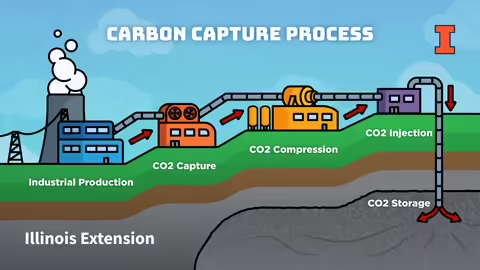URBANA, Ill. – In addition to reducing carbon emissions, innovations in the capture, transport, and storage of carbon dioxide hope to help reduce atmospheric CO2 emissions.
Officials at public meetings in central Illinois describe the plan to transport CO2 through 1,300 miles of underground pipeline, crossing 12 Illinois counties, ending at a central Illinois location for storage in underground rock.
Storage of CO2 is not new.
"Illinois was the first to develop a carbon dioxide storage system from industrial sources," says Duane Friend, University of Illinois Extension natural resources, environment, and energy educator. "Geologists and engineers from the U of I Prairie Research Institute and the Illinois State Geological Survey have been working on these methods for over 20 years."
The process passed safety tests.
"Researchers and engineers, working with ADM, closely monitored the capture, injection, and observation of the Decatur-based site," Friend says. The carbon dioxide was pumped more than a mile under ground.
The Intergovernmental Panel on Climate Change estimates more than 1,500 miles of pipeline in the United States currently carries carbon dioxide, with some of the pipelines in operation more than 40 years.
"Most of this infrastructure has been used to aid in oil and gas extraction," Friend says.
Why store carbon dioxide in Illinois?
Illinois' deep underground rock is well suited for CO2 storage, Friend says.
"Hundreds of millions of years ago when Illinois was part of a shallow sea, huge amounts of coarse sediments were deposited that eventually became sandstone," Friend says. The Mt. Simon sandstone layer lies from 5,000 to over 7,000 feet below ground under much of central and northern Illinois.
"This rock layer, 500 to over 2,500 feet thick, is porous enough to accept liquid CO2, but not let it travel very far from the point of injection," Friend says. "Multiple layers of impermeable rock above it keeps the CO2 from migrating upward, much like trapped oil and gas that is closer to the surface."
How does the extraction work?
Friend explains that In the Archer Daniels Midland operation, carbon dioxide is captured and compressed; then, the water is removed. It enters the pipeline at an injection well on the surface, before being pumped and injected into the sandstone.
The research site monitored seismic activity and soil, groundwater, and air quality. Shallow groundwater and deep subsurface monitoring tracked movement of the CO2, Friend says. The 3-year research confirmed the operation worked with no major adverse effects, Friend says.
"This procedure should be considered just one of many options to reduce atmospheric CO2 emissions, which adds 35 billion metric tons of carbon dioxide to Earth's atmosphere each year," Friend says.
SOURCE: Duane Friend, Illinois Extension Educator, Natural Resources, Environment, and Energy
EDITOR: Judy Mae Bingman, Illinois Extension Marketing and Communication Manager
ABOUT ILLINOIS EXTENSION: Illinois Extension leads public outreach for University of Illinois by translating research into action plans that allow Illinois families, businesses, and community leaders to solve problems, make informed decisions, and adapt to changes and opportunities.
